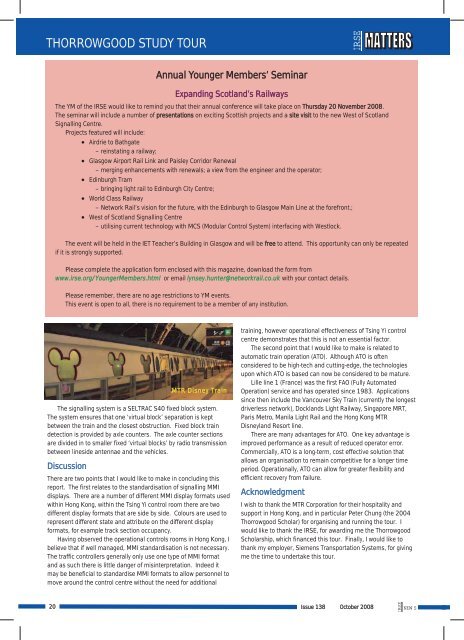IRSE News 138 Oct 08.pdf
IRSE News 138 Oct 08.pdf
IRSE News 138 Oct 08.pdf
You also want an ePaper? Increase the reach of your titles
YUMPU automatically turns print PDFs into web optimized ePapers that Google loves.
THORROWGOOD STUDY TOUR<br />
<strong>IRSE</strong><br />
Annual Younger Members’ Seminar<br />
Expanding Scotland’s Railways<br />
The YM of the <strong>IRSE</strong> would like to remind you that their annual conference will take place on Thursday 20 November 2008.<br />
The seminar will include a number of presentations on exciting Scottish projects and a site visit to the new West of Scotland<br />
Signalling Centre.<br />
Projects featured will include:<br />
Airdrie to Bathgate<br />
– reinstating a railway;<br />
Glasgow Airport Rail Link and Paisley Corridor Renewal<br />
– merging enhancements with renewals; a view from the engineer and the operator;<br />
Edinburgh Tram<br />
– bringing light rail to Edinburgh City Centre;<br />
World Class Railway<br />
– Network Rail’s vision for the future, with the Edinburgh to Glasgow Main Line at the forefront.;<br />
West of Scotland Signalling Centre<br />
– utilising current technology with MCS (Modular Control System) interfacing with Westlock.<br />
The event will be held in the IET Teacher’s Building in Glasgow and will be free to attend. This opportunity can only be repeated<br />
if it is strongly supported.<br />
Please complete the application form enclosed with this magazine, download the form from<br />
www.irse.org/YoungerMembers.html or email lynsey.hunter@networkrail.co.uk with your contact details.<br />
Please remember, there are no age restrictions to YM events.<br />
This event is open to all, there is no requirement to be a member of any institution.<br />
The signalling system is a SELTRAC S40 fixed block system.<br />
The system ensures that one ‘virtual block’ separation is kept<br />
between the train and the closest obstruction. Fixed block train<br />
detection is provided by axle counters. The axle counter sections<br />
are divided in to smaller fixed ‘virtual blocks’ by radio transmission<br />
between lineside antennae and the vehicles.<br />
Discussion<br />
MTR Disney Train<br />
There are two points that I would like to make in concluding this<br />
report. The first relates to the standardisation of signalling MMI<br />
displays. There are a number of different MMI display formats used<br />
within Hong Kong, within the Tsing Yi control room there are two<br />
different display formats that are side by side. Colours are used to<br />
represent different state and attribute on the different display<br />
formats, for example track section occupancy.<br />
Having observed the operational controls rooms in Hong Kong, I<br />
believe that if well managed, MMI standardisation is not necessary.<br />
The traffic controllers generally only use one type of MMI format<br />
and as such there is little danger of misinterpretation. Indeed it<br />
may be beneficial to standardise MMI formats to allow personnel to<br />
move around the control centre without the need for additional<br />
training, however operational effectiveness of Tsing Yi control<br />
centre demonstrates that this is not an essential factor.<br />
The second point that I would like to make is related to<br />
automatic train operation (ATO). Although ATO is often<br />
considered to be high-tech and cutting-edge, the technologies<br />
upon which ATO is based can now be considered to be mature.<br />
Lille line 1 (France) was the first FAO (Fully Automated<br />
Operation) service and has operated since 1983. Applications<br />
since then include the Vancouver Sky Train (currently the longest<br />
driverless network), Docklands Light Railway, Singapore MRT,<br />
Paris Metro, Manila Light Rail and the Hong Kong MTR<br />
Disneyland Resort line.<br />
There are many advantages for ATO. One key advantage is<br />
improved performance as a result of reduced operator error.<br />
Commercially, ATO is a long-term, cost effective solution that<br />
allows an organisation to remain competitive for a longer time<br />
period. Operationally, ATO can allow for greater flexibility and<br />
efficient recovery from failure.<br />
Acknowledgment<br />
I wish to thank the MTR Corporation for their hospitality and<br />
support in Hong Kong, and in particular Peter Chung (the 2004<br />
Thorrowgood Scholar) for organising and running the tour. I<br />
would like to thank the <strong>IRSE</strong>, for awarding me the Thorrowgood<br />
Scholarship, which financed this tour. Finally, I would like to<br />
thank my employer, Siemens Transportation Systems, for giving<br />
me the time to undertake this tour.<br />
20<br />
Issue <strong>138</strong> <strong>Oct</strong>ober 2008<br />
<strong>IRSE</strong><br />
NEWS

















